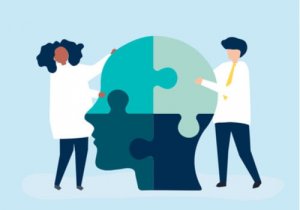Psychosocial Intervention in Mental Health

According to the World Health Organization (WHO), health is a state of complete physical, mental, and social well-being, and not just the absence of conditions or diseases. Well, in order to achieve or preserve this state, you can use different strategies within different fields. One of these spaces of knowledge and application is, in fact, psychosocial intervention.
Before expanding on this, it’s important that we all understand what psychosocial intervention is. According to Alvis (2009), psychosocial intervention is a process which aims at increasing the development capacity of human beings, their families, and communities.
It allows subjects to exercise control and power over their individual and social environment. That way, it increases people’s well-being and quality of life, training and providing them with individual tools that will allow them to face and solve problems as well as make changes in their social environment.
“What mental health needs is more sunlight, more candor, and more unashamed conversation.”
-Glenn Close-
What’s mental health?
As Oramas, Santana, and Vergara (2013) said, mental health consists of learning about reality to then transform it through confrontation, management, and integrating conflict resolution; both internal to the individual and those surrounding them. When there’s a disturbance in this learning process, or if the individual fails in the attempt of their resolution, one can begin to talk about illness.
Other authors such as Riviere said something along the same lines, that mental health is conceived as the ability to maintain dialectical and transformative relationships with the world which allow the resolution of the individual’s internal contradictions as well as those related to their social context. (Quoted by Oramas, Santana, and Vergara. 2013).
According to the World Health Organization, mental health is defined as “a state of well-being in which every individual realizes his or her own potential, can cope with the normal stresses of life, can work productively and fruitfully, and is able to make a contribution to her or his community”.

Although people’s ability to handle day-to-day conflicts and transform their reality is of great importance, there are other decisive factors when it comes to mental health:
- The social context. Situations of poverty, abuse, or belonging to minority groups.
- Family background.
- Comorbidity with other chronic diseases.
Psychosocial intervention is carried out through two interrelated contexts: psychological and social. The individual must start by taking into account their entire social environment and the one they interact with. When intervening, it’s important to remember just how important the role of primary care professionals really is. This is the closest and most accessible service. From there on, the experienced professionals will evaluate and transfer the patient.
Something we must keep in mind is that the coordinated effort of the different professionals is essential to reach goals. Although pharmacological treatment can be important, (always prescribed by a professional, of course), it’s important that we don’t forget about the relevance of psychosocial intervention.
As indicated in the Good Practices in Intervention for People with Mental Illness (2016) guide, this intervention must include social support, monitoring, accompaniment, and social rehabilitation. The main objective of this practice is contributing to the autonomy of an individual suffering from a mental illness.
Users must get individual and personalized attention. Here are some things we must bear in mind:
- The individual’s needs.
- Support from their family or closest circle.

Psychosocial intervention in people with mental illness includes:
- Activities related to their living situation: supervision, assistance while searching for accommodation, etc.
- Daily activities.
- Support for instrumental daily activities.
- Supervision and training for medication administration.
- Guidance when working with organization and time management.
- Training for social and family life.
- Socio-legal advice.
In brief, people are now more aware of the importance of mental health than a few years ago. However, there’s still so much more to learn and understand in regards to mental illnesses. Little by little, we as a society should become more empathetic, tolerant, and informed about this topic.
For this and other reasons, it’s important to encourage those who may need to go see a mental health professional and help them understand just how helpful psychosocial intervention could be for them.
“Mental illness is nothing to be ashamed of, but stigma and bias shame us all.”
-Bill Clinton-
All cited sources were thoroughly reviewed by our team to ensure their quality, reliability, currency, and validity. The bibliography of this article was considered reliable and of academic or scientific accuracy.
- Alvis. A. (2009). Aproximación teórica a la intervención psicosocial. Poiésis, 9(17).
- Bernal, P., Diana, J. J., Carroza, E., Fábregas, D., Fernández, C., González, C., Jímenez, A., Jurado, P., López, P., Luque, S., Pareja, N., Rosa, J.J., Ruíz, F., Sánchez, N., Torres, A. y Torres, S. (2016). Guía de Buenas prácticas en intervención por personas con enfermedad mental. Feades Andalucia Salud Mental.
- Hernández, B. (2013). El Trabajo Social en la intervención psicosocial con personas con trastorno mental severo: una reflexión sobre el papel de las familias. Documentos de trabajo social: Revista de trabajo y acción social, (52), 314-325.
- López, M., & Laviana, M. (2007). Rehabilitación, apoyo social y atención comunitaria a personas con trastorno mental grave: propuestas desde Andalucía. Revista de la Asociación Española de Neuropsiquiatría, 27(1), 187-223.
- Oramas, A., Santana, S, & Vergara, A. (2013). El bienestar psicológico, un indicador positivo de la salud mental.
This text is provided for informational purposes only and does not replace consultation with a professional. If in doubt, consult your specialist.








